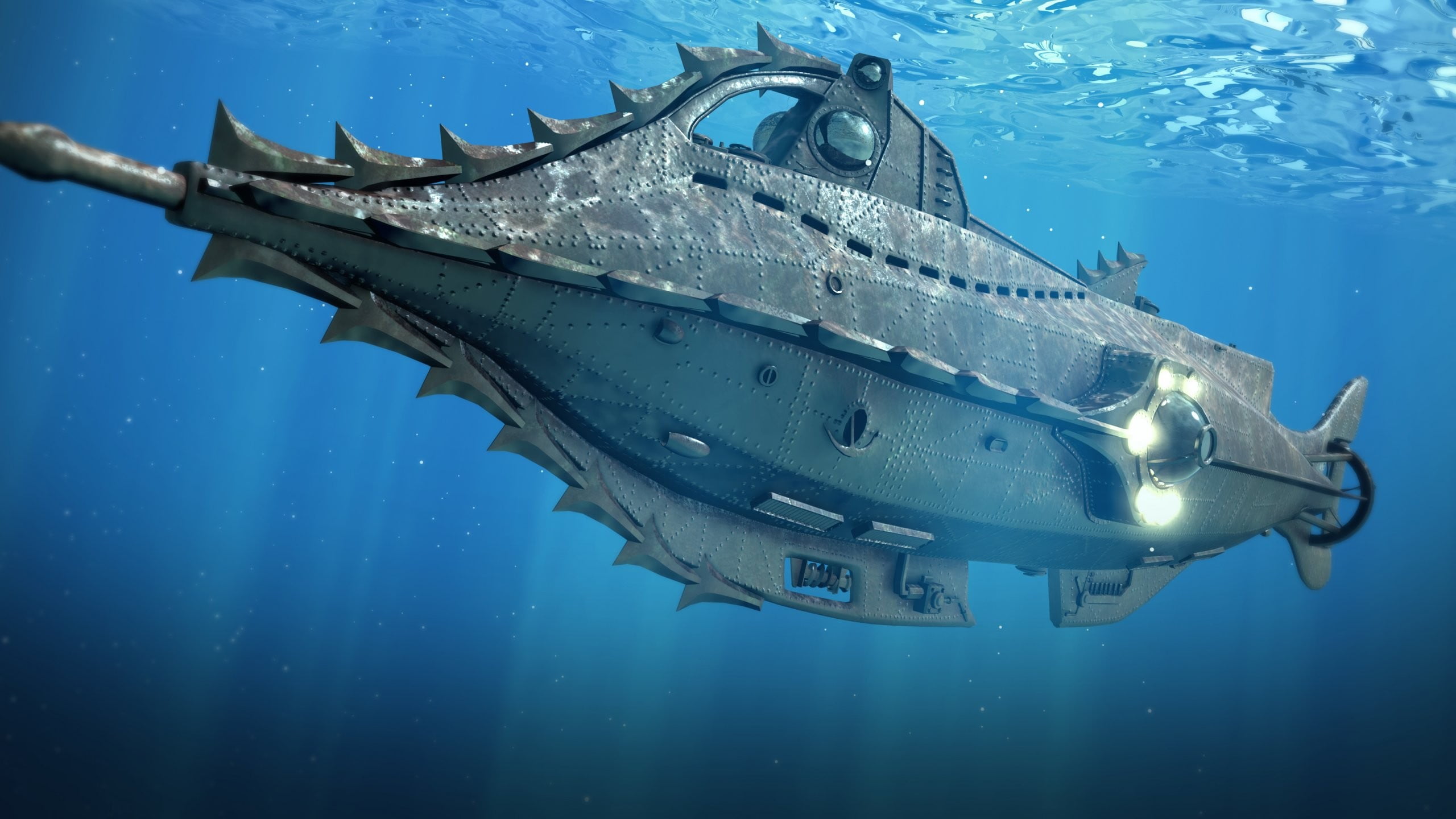I've really been enjoying making one shots recently. I don't play super frequently, but in the last month alone I made a one shot for Mork Borg that I tried out with some friends from a friend (and I learned that the Mork Borg system really isn't for me) and I made a one shot for the GLoG (specifically Arnold Kemp's setting Centerra) that I played with some folks I know from the FKR Collective discord server.
That last one, The Brass Spire, worked supprisingly well (though the players of the Mork Borg game said they had fun as well, I really didn't like the combat in that system so for me the experience was a bit more mixed), so I'd like to reflect on why that may be. Before that though, let me gives a brief overview of the adventure and a quick summary of what happened.

Yes, this is going to be an underwater adventure. But don't worry, its mostly all dry!
The Adventure:
In short, The Brass Spire (working title) is another attempt by me to jaquays a 5-room dungeon:
- Basically it is a tall building, floorplan looks like an 8 with the top circle being a lot smaller than the bottom one.
- The tiny circle at the top is an elevator shaft that runs all the way from the top to the bottom.
- The bigger bottom circle houses 4 rooms stacked ontop of one another, meaning that basically every floor is only a single room.
- You can enter the structure either from the top of the elevator shaft, from a balcony at the top floor or a secret entrance at the bottom floor.
- The entire thing is underwater, but weird membrames are keeping water from entering through the 'normal entrances'. Holes, cracks and openings that wouldn't normally occur will cause water to seep in.
- There is a portable mechanism that allows you to rearrange the rooms, allowing for example to switch the locations of room 3 and room 1.
- Inside the Brass Spire, anti-priests are scheming and it probably has something to do with the hooks given to the players, but there is also a Devil looking to bring the heretic anti-priests to justice (and will do the same to any other heretics they might encounter) as well as some merfolk related stuff and an independent creature that has simply taken residence in one of the rooms.
For a full overview of the adventure, feel free to check out this document (though it is very unpolished it does have a map which might be of use I guess).
The Session:
- My players started off in a port town in Centerra (Guilder) where they were given three pieces of information:
1) The whales have stopped coming up from Hell and this is causing tensions between humans and merfolk to escalate.
2) Anti-priests have at first become really visible throughout the town only to then suddenly disappear completely right before the whale shortage.
3) A weird brass 'temple' off of the coast of Guilder has been sighted by an inventor testing her diving machine and she wishes to loot it for ancient machinery, but requires some adventurers to acompany her. - Players were given 1 thing of approximately 1 hour to do before heading down. Yawn, a paladin of the Word, spend this time practicing holding their breath. Cooky and Company, a group of goblins that multiclassed into a baking class, used it to bake some cookies.
- After delving underwater players got to choose where to enter the structure from.
- Finding it difficult to enter, they eventually managed and survived their interaction with the Eldrox, taking up residence in the top chamber.
- They recruited a Devil and 2 anti-priests in the room beneath this one and found in the same room a strange brass cube, the size of a backpack and supprisingly light, with a flat sapphire interface on it.
- Afterwards they all took an elevator down, taking the cube with them, passing one room, bathed in red light, walls covered with whale imagery and a merfolk, clearly entranced, holding their hand on top of an effigy of the Kraken.
- When they reached the bottom floor, the goblins activated the cube, used it to rearrange levels 1 (with the Eldrox) and 3 (with the merfolk), causing water to enter the spire and slowly floading the lowest level.
- They raced past the anti-priests and anti-paladins occupying the lowest level, rushed down the secret entrance at the bottom of the spire and managed to just barely get to the diving machine the anti-priests and -paladins had used to get here before it was ready to leave.
- They fought off the anti-paladin leader, discovered that what they assumed was the anti-pope in a litter was actually a doll and barely managed to take off in their new diving machine.
- During all of this they had to leave behind 2 priceless religious relics used by the anti-priests and 1 cube interface thingy that manipulates this (and maybe other?) brass structure(s), but managed to get themselves their very own diving machine, either to sell off or to use to return to the spire at a later point or to go on other deep water adventures.

I mean, even if one of these is all you get out of an adventure, I would call that a succes.
The (potential) reasons it worked
Now to be honest, thinking back this one shot should have failed. One person had an unexpected work thing and had to leave halfway through the game only to reappear later on again. Another person got ill and dropped out of the game before we even started. These things happen and I can't get upset about them even if I tried, but these last minute changes made it so that it is kinda weird that the game went as well as it did. So lets try to see why that might be:
Just a one-shot, but more than a one-shot
I think this was the first time I played a game that was intended to end after one session, which ended after one session, but left the players wanting more of the same dungeon.
The reason for this I think is that despite making basically a 5-room dungeon, I filled it with too much to experience in 2 hours of play. And I think this is a good thing. I always took 'leave your players wanting for more' to apply primarly to multiple session games, but it worked really well for this one shot. By putting in more than could reasonably be handled all at the same time, this caused there to always be something that the players wouldn't have time for and thus leave them not only with answers, but also with questions.
IMPACT
One would make it really hard for me to argue against accusations that at this point I am just a Chris McDowall fanboy and if I were to be willing to accept that charge I would be refering to ICI-doctrine now. So to alleviate some of that I'll instead refer to Arnold Kemp as the source of this principle: Make choices of the PCs have impact.
Giving the players the option to alter the dungeon had the possibility of making their choices matter less. Especially as they could get to a point where they could do that fairly quickly. However, doing so causes the Spire to flood, meaning that doing so has very immediate consequences. Consequences that can to some extend be mitigated by moving the around again so that the stuff you need to access is up in the dry bits, but this then makes more of the building flood.
Also, though this has to do more with my GMing style and not so much with the design of the adventure, I don't mind it when stuff goes completely of the rails. So whenever my players did something weird, I would mostly let them. Did I plan for the players to be able to persuade the Devil into being their ally? Yes. The anti-priests though? Not really, but I wasn't fundamentally against it. One of the freaking main antagonists? Well that possibility never even occured to me, but when the situation presented itself in game and actually made sense I did allow it to happen. The fact that a situation arose that made that the logical conclusion was because of the following thing that worked well:
Wandering 'Bosses' OR finishing the dungeon on the fly
I don't think I have ever seen a 5-room dungeon with wandering encounters. The traditional 5-room dungeon (a linear design meant to impose a structure found in a lot of western movies onto tRPGs) is almost like the antithesis of dungeons large enough to have wandering encounters. Still, when I got more stuff than I wanted to put in any particular room but did still want to include in this adventure, I just put them into a wandering encounter list.
The reason this worked I think was two-fold:
On the one hand, it dismanteled some of the things I personally really hate about most 5-room dungeons, namely that Hollywood structure of rising action, darkest hour, climax and sequal baiting at the end. By not having somewhere predetermined in mind for a lot of the main content of my dungeon (the two main antagonists where on the freaking wandering encounter table for crying out loud), there was always still emergent story telling. And by making sure I rolled twice on the encounter table, I didn't spring something weird on my players in some sort of gotcha moment, but instead was able to present some of the background conflicts by playing out the natural result of these two entrees interacting with one another.
On the other hand, I didn't bind myself to the mechanic. With which I don't mean that I fumbled anything, but that I took the results of the random encounter when they came up and based on what that implied about the rest of the situation, filled in the blanks from there. Let me clarify with an example:
I rolled that in room 2, a Devil (send by the Church to test which heretics actually believed their herecy and drag the souls of those that do back to hell) was interacting with an anti-cardinal (who, together with his sister is behind the anti-congregation even being in the Spire) and his eunich (a lv 3 mage that helps the anti-cardinal pretend he is has any real worldly power). From the conversation that I assumed these 3 would naturally be having it became apparant that some more of the anti-congretation as well as the sister of the anti-cardinal should be in the Spire as well. So when the party went down deeper into the Spire, I put his sister in, and rolled on the random encounter table to see who she was accompanied by (I rolled d6 anti-priests practicing sermons, but could just as easily have rolled the 2d4 merfolk, which would have implied a lot of dead anti-priests and -paladins on the floor, or 1d3+1 anti-paladins showing off, or even something I had already rolled up, meaning that she would be by herself for whatever reason).
Side note: Please do note that the placement of the sister of the anti-cardinal wasn't based on some meta-narrative reason or genre trope that required there to be a 'boss' at the end of the dungeon. I placed here where I did because it made the most sense to put her there after I rolled the random encounters. Had the party made different decisions they might have never encountered her despite me putting her there (they could have entered the Red Room with the Merfolk in it, or when randomly deciding which floors to swap have rolled a 4 rather than the 3 and the 1 which they ended up swapping, etc.). I mention this not because I am inherently against using meta-narrative decision making or fudging results, but because I genuinely think there is a difference here. Basically, I mean to show that you can do stuff like this, even if (like me) using meta-narrative decisions or fudging isn't something you tend to like in your games.

They still don't know why the whales have stopped coming though. Wonder if that is going to cause some problems.
Take aways:
In short I think the three lessons I learned from this one shot are as follows:
- Overfill your adventure one-shots to generate that feeling of 'wanting more' in your players without having to imply that there will actually be another session (as this inherently makes it not so much a one-shot as an opening adventure).
- Design one-shot adventures with a lot of Impact in mind and really lean into this during play. This adventure basically had a 'destroy the dungeon?' button in it and it worked really well.
- Wandering Encounters can definitely be used in small dungeons (even ones as small as this one) as long as you allow that mechanic to be a tool to generate an interesting situation and not a law that must be followed even against the established rules of the world (basically just play games FKR already!).
Also, jaquaysing 5-room dungeons is a lot more fun than I thought. The harsh limitations really force me to come up with a lot of interesting fixes that I don't think I would otherwise come up with. So take that for a secret fourth lesson I guess.
No comments:
Post a Comment